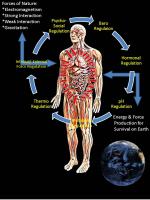|
This section contains 569 words (approx. 2 pages at 300 words per page) |

|
Homeostatic mechanisms control a property of all living things called homeostasis. Homeostasis is a built-in, automated, and essential property of living systems. Breathing is an example of a homeostatic property. Homeostatic mechanisms are self-regulating mechanisms that function to keep a system in the steady state needed for survival. These mechanisms counteract the influences that drive physiological properties towards a more unbalanced state.
The recognition of homeostasis and homeostatic mechanisms dates from the nineteenth century. Then, the French physiologist Claude Bernard observed the constancy of the composition of blood and other body fluids. He proposed that such constancy was vital for life. Indeed, the word homeostasis is from the Greek words for "same" and "steady". The term was coined in 1930 by physiologist Walter Cannon in a book called The Wisdom of the Body.
The mechanisms that regulate homeostasis operate by feedback mechanisms. Negative and positive feedback mechanisms...
|
This section contains 569 words (approx. 2 pages at 300 words per page) |

|


